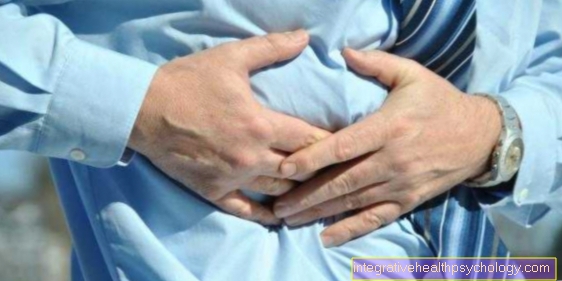Nexium®
synonym
Proton pump inhibitor, proton pump inhibitor, "stomach protection"
introduction

A total of 2-3 liters of gastric juice are produced daily by various cells in the stomach. It contains aggressive substances such as hydrochloric acid and digestive enzymes, but also protective substances that prevent the stomach from digesting itself. The pH value, which indicates how acidic a liquid is, is 1-2 in the stomach, i.e. in the very acidic range. This acidic fluid is important as certain digestive enzymes only work in these areas. On the other hand, certain pathogens are killed off just by the acidic pH in the stomach.
Read more on the topic: PH value
There are certain factors that increase the production of acidic substances in the stomach. These include unpleasant factors such as stress, fear, and pain as well as food intake. If you "mouth water" at the sight of food, more stomach acid is produced at the same time, so that digestion, especially of proteins, can begin.
There are several reasons why excessive acid production in the stomach is harmful. For example, drugs such as ASA, ibuprofen and diclofenac can, however, also alcohol and nicotineattack the protective layer of the stomach and cause inflammation.
A strongly acidic environment is also a perfect place for the Helicobacter Pylori bacterium to multiply and reside. About 80% of the chronic Attribute inflammation of the stomach lining to an infection with this bacterium.
The gastric ulcer is another disease that can always be traced back to an unbalanced balance between acidic gastric juice and fluids that protect the stomach.
Heartburn (reflux esophagitis) causes stomach acid to rise up into the esophagus. This leads to inflammation there.
The acid production in the stomach can be reduced by various drugs, one of which Nexium® is. Nexium® belongs to the group of proton pump inhibitors and is therefore one of the most effective drugs that can inhibit the production of acid in the stomach.
definition
Nexium® is a prescription drug from the company AstraZeneca from the group of proton pump inhibitors, which against too strong acid production in the stomach is applied.
Trade name
Nexium®
Chemical name
Esomeprazole
Dosage forms
- Nexium® Mups 20mg (Multiple Unit Pellet System)
- Nexium® Mups 40mg (Multiple Unit Pellet System)
- Nexium® 40mg powder for solution for infusion
Mechanism of action
With its active ingredient esomeprazole, Nexium® is one of the Proton pump inhibitors. The active ingredient is absorbed as a so-called pro-drug, which means that it only absorbed in the small intestine is circulated in the blood and then works in the cells of the stomach. Nexium® must therefore in an acid-proof capsule be taken as the stomach acid would break down the active ingredient. The active ingredient becomes active in the cells of the stomach and acts on a proton pump (medical: proton potassium ATPase) in the so-called parietal cells of the stomach. The proton pump pumps protons into the stomach, where they cause the amount of hydrochloric acid (HCL) to increase through a chemical reaction. This pump is responsible for the production of stomach acid. Nexium® starts at this pump and irreversibly inhibits it. That means that the Nexium® significantly reduces the amount of acid in the stomach can be.Since about a third of the proton pumps are formed every day, there is no complete inhibition of acid production. In order to maintain the effect of NNexium®, another tablet must be taken after 24 hours.
Areas of application for Nexium®
Nexium® is used for reflux esophagitis, gastroesophageal reflux disease (GERD), Helicobacter pylori infection, and ulcer of the stomach or duodenum.
Side effects
Like all proton pump inhibitors, Nexium® is generally well tolerated. Adverse effects are rare and minor, with gastrointestinal disorders occurring in 1-2% of those treated. This can lead to symptoms such as abdominal pain, nausea, vomiting, diarrhea, constipation and flatulence. In some cases, taking Nexium® can also lead to tiredness, sleep disorders, dizziness, depression and joint pain.
Intravenous administration of an infusion solution of Nexium® can also lead to impaired vision and hearing.
If side effects occur, a doctor should be consulted immediately, who can decide on further measures.
Interactions

The use of Nexium® can lead to an interaction with other drugs. Since Nexium® leads to a lower acid content in the stomach, the absorption of some drugs is influenced. This is the case with, for example Ketoconazole and Itraconazole, both drugs for a fungal infection. In addition, a doctor should be consulted if the drugs atazanavir and nelfinavir (for HIV infection) are taken.
Since Nexium® is broken down by an enzyme that also breaks down other drugs, there can also be interactions there. This leads to higher concentrations of the antidepressants citalopram, imipramine and Clomipramine and the sedative diazepam.
Conversely, through the same effect, Clarithromycin (an antibiotic) increase the levels of Nexium® in the body as it inhibits its breakdown.
A doctor should also be informed if the bleeding-thinning drug is used Warfarin is applied.
Further interactions when taking Nexium® can occur when taking at the same time Casapride, Digoxin, Rifampicin, and St. John's wort.
Contraindications
Nexium® should not be taken if hypersensitivity to the active substance esomeprazole is known. In addition, as mentioned above, medication with the AIDS drugs atazanavir and nelfinavir speaks against taking Nexium®.
There are no studies on the use of Nexium® in children, therefore Nexium® not in children be applied. Pregnant women should only use Nexium® under the supervision of a doctor, and not during breastfeeding take in.
particularities
It is important to ensure that Nexium® not crumbled, ground or otherwise crushed is taken. This would destroy the acid-resistant capsule and destroy the drug in the stomach without it being able to develop its effect.
price
Compared to other proton pump inhibitors, Nexium® has a comparable effect expensive. This is how the pack of Nexium® Mups costs 20mg (15 pieces) 29,55€ and the pack of Nexium® Mups 40mg (15 pieces) 36,38€ (As of June 2014). Replicas (medical: generics) of the drug with the active ingredient omeprazole sometimes cost significantly less, with the same effect. The drug Esomep, also from the AstraZeneca company, contains the same active ingredient and is otherwise identical to the original, but around 20% cheaper than Nexium®.
history
Before Nexium®, also from AstraZeneca, the drugs Antra® and Prilosec® were on the market, which contained the active ingredient omeprazole. After the patent for the active ingredient Omeprazole Expired in 1999, the drug Nexium® with the active ingredient was introduced in 2000 Esomeprazole launched by AstraZeneca. The only difference to the predecessor was the breakdown of the drug, which was now a little slower, which meant that the active ingredient remained in the blood longer.
In 1998 the pharmaceutical company AstraZeneca developed a new dosage form for the group of proton pump inhibitors with the active ingredient omeprazole: the so-called MUPS (Multiple Unit Pellet System), which, according to AstraZeneca, are better absorbed. Nexium® brought the manufacturer AstraZeneca a turnover of 5 billion dollars in 2009 alone.
Current
Nexium® has been available without a prescription in the US since March 2014.
criticism
The introduction of Nexium® was partly interpreted as a protection against generics for the drugs Antra and Prilosec. Nexium® was introduced at the time when Antra and Prilosec lost their patent, and was the same in effect. Only the active ingredient was changed a little. AstraZeneca stated that clinical studies have shown it to be effective, but some experts strongly disagree with this statement.



























.jpg)

